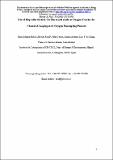Por favor, use este identificador para citar o enlazar a este item:
http://hdl.handle.net/10261/157391COMPARTIR / EXPORTAR:
 SHARE SHARE
 CORE
BASE CORE
BASE
|
|
| Visualizar otros formatos: MARC | Dublin Core | RDF | ORE | MODS | METS | DIDL | DATACITE | |

| Título: | Use of hopcalite derived Cu-Mn mixed oxide as oxygen carrier for Chemical Looping with Oxygen Uncoupling Process |
Autor: | Adánez-Rubio, Iñaki CSIC ORCID; Abad Secades, Alberto CSIC ORCID ; Gayán Sanz, Pilar CSIC ORCID ; Adánez-Rubio, Imanol CSIC; Diego Poza, Luis F. de CSIC ORCID ; García Labiano, Francisco CSIC ORCID ; Adánez Elorza, Juan CSIC ORCID | Palabras clave: | CO2 capture Combustion Coal CLOU Mixed oxide Copper Manganese |
Fecha de publicación: | 10-jun-2016 | Editor: | American Chemical Society | Citación: | Energy and Fuels 30(7): 5953-5963 (2016) | Resumen: | Chemical-Looping with Oxygen Uncoupling (CLOU) is an alternative Chemical Looping process for the combustion of solid fuels with inherent CO2 capture. The CLOU process needs a material as oxygen carrier with the ability to give gaseous O2 at suitable temperatures for solid fuel combustion, e.g. copper oxide and manganese oxide. In this work, treated commercial Carulite 300® was evaluated as oxygen carrier for CLOU. Carulite 300® is a hopcalite material composed of 29.2 wt.% CuO and 67.4 wt.% Mn2O3. Oxygen release rate and the fluidization behavior, regarding agglomeration and attrition rate, were analyzed in a TGA and in a batch fluidized bed respectively. Experiments in a batch fluidized bed reactor were carried out at temperatures ranging from 800 to 930 ºC with a medium volatile bituminous coal from South Africa and its char as fuels. The hopcalite derived oxygen carrier showed high O2 release rate, no unburnt products at low oxygen carrier to fuel mass ratios and very high oxygen transference rate by gas-solid reaction. This material has the capacity to generate gaseous oxygen at lower temperatures than Cu-based oxygen carriers, which suggest this material is suitable to work at lower temperatures in the fuel reactor without the presence of unburnt products; however its low mechanical resistance after redox cycles makes necessary an improvement of its physical properties for being use as an oxygen carrier. | Versión del editor: | https://doi.org/10.1021/acs.energyfuels.6b00552 | URI: | http://hdl.handle.net/10261/157391 | DOI: | 10.1021/acs.energyfuels.6b00552 | ISSN: | 0887-0624 |
| Aparece en las colecciones: | (ICB) Artículos |
Ficheros en este ítem:
| Fichero | Descripción | Tamaño | Formato | |
|---|---|---|---|---|
| Postprint EnergyFuels 30_2016_5953_5963.pdf | 1,72 MB | Adobe PDF |  Visualizar/Abrir |
CORE Recommender
SCOPUSTM
Citations
28
checked on 09-may-2024
WEB OF SCIENCETM
Citations
22
checked on 27-feb-2024
Page view(s)
313
checked on 17-may-2024
Download(s)
233
checked on 17-may-2024
Google ScholarTM
Check
Altmetric
Altmetric
NOTA: Los ítems de Digital.CSIC están protegidos por copyright, con todos los derechos reservados, a menos que se indique lo contrario.
